
About 4 million Americans aged 40 or older are either blind or have severe vision loss, according to a new report by the U.S. Centers for Disease Control and Prevention. But the South appears to have more than its share of people with vision problems. Three out of four of the counties with the highest prevalence of vision loss were in the South, the report noted.
This high concentration of vision loss is probably because the South has a higher concentration of poverty, as well as of diabetes and other chronic diseases.
For the country as a whole, the incidence of blindness or severe vision loss is 3%. But Owsley County in Kentucky has the highest rate in the country; more than 18%, which is about one in every six people.
The rates for severe vision loss were 11.7% in the West, 10.7% in the Midwest, and 0.3% in the Northeast. The report defined severe vision loss as visual acuity with glasses or other correction of more than 20/40 in the better-seeing eye.
Counties with high prevalence of severe vision loss tended to be those with high poverty levels. Among the top 25% of counties for prevalence of severe vision loss, 55.5% were also in the top 25% for rates of poverty. Of the counties in the top 25% for both vision loss and poverty, 83.1% were in the South, 9.1% in the West, and 7.8% in the Midwest. No county in the top 25% for prevalence of both severe vision loss and poverty was located in the Northeast.
The most common causes of vision loss among adults are cataracts, diabetic retinopathy, glaucoma, and age-related macular degeneration. All of these conditions can develop gradually without warning signs. The CDC's report called for counties with a high rate of vision loss to reduce risk factors such as smoking and poor diet and promoted eye safety and routine eye examinations.
You can read the report at http://www.cdc.gov/mmwr/preview/mmwrhtml/mm6419a2.htm?s_cid=mm6419a2_w.



